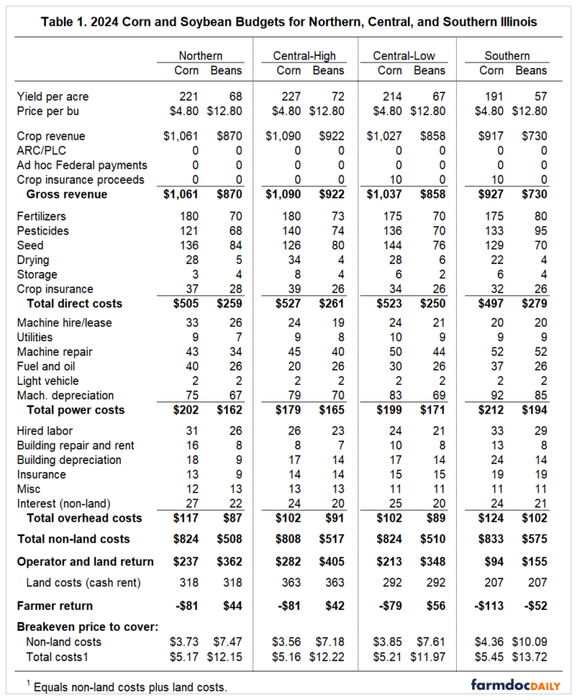By Gary Schnitkey, Nick Paulson, and Jim Baltz, Department of Agricultural and Consumer Economics, University of Illinois and Carl Zulauf, Department of Agricultural, Environmental and Development Economics, Ohio State University
Corn and soybean budgets for 2024 are now available here on the farmodc website. Overall, projections are for lower costs on both corn and soybeans in 2024 than in 2023. The lower costs predominately come from fertilizer price reductions. Even given cost reductions, break-even prices are above $5.00 per bushel for corn and $12 per bushel for soybeans across all regions of Illinois. Current projections favor soybeans.
2024 Crop Budgets
Budgets are prepared for three regions of Illinois: northern, central, and southern Illinois (see Table 1). Central Illinois budgets are further broken down based on high and low-productivity farmland. From 2018 to 2022, average yield for central-high productivity farmland was 223 bushels per acre, while yields averaged 207 bushels per acre for the central low productivity farmland.
The basis for budgets is farm records from Illinois Farm Business Farm Management (FBFM). FBFM records for each of the four breakdowns are available from 2017 to 2022 in a publication on farmdoc entitled “Revenue and Costs for Illinois Grain Crops.” The projections in Table 1 are updated from historical summaries in the following manner:
Projected yields are based on historical trends (see farmdoc daily, June 6, 2023, for a discussion of trend yields). Trend yield projections for corn are 221 bushels per acre for northern Illinois, 227 for central-high, 214 for central-low, and 191 for southern Illinois. Trend yields for soybeans are 68 bushels per acre for northern Illinois, 72 bushels per acre for central-high, 67 for central-low, and 57 for southern Illinois.
Corn and soybean prices are based on current futures prices on Chicago Mercantile Exchange (CME) contracts that will be used to market the 2024 crop. Projected 2024 prices are $4.80 per bushel for corn and $12.80 for soybeans.
Projected 2024 cost levels are based on 2022 levels, the last year for which FBFM summaries exist. Those 2022 levels are updated based on changes in input prices.
The only revenue included in the 2024 budget is crop revenue. The traditional commodity programs — Agricultural Risk Coverage (ARC) and Price Loss Coverage (PLC) would not make payments at prices and yields used to construct these budgets. Ad hoc Federal programs could provide an alternative source for payments, but those would require congressional or administrative action.
Total non-land costs include:
Direct costs — these costs will vary with the crop planted and include fertilizer, pesticides, seed, drying, storage, and crop insurance.
Power costs relate to machinery and power and include machinery hire, utilities, machine repair, fuel and oil, light vehicle, and machinery deprecation.
Overhead costs include hired labor, building repair and rent, building depreciation, insurance, miscellaneous., and interest on non-land costs.
Operator and land return equals gross revenue minus non-land costs and represents a return to the farmer and landowner. Subtracting out land costs results in a farmer return.
Projected 2024 farmer returns are negative for corn:
-$81 per acre for northern Illinois, -$82 per acre for central-high, -$79 for central-low, and -$113 for southern Illinois. Soybeans are projected to be more profitable than corn. Soybeans in southern Illinois are projected at $44 per acre, $42 per acre in central-high, $56 in central-low, and -$52 in southern Illinois.
Table 1 shows break-even prices to cover non-land costs and total costs. Total costs include non-land and land costs. Break-even prices to cover total costs exceed $5.00 per bushel for corn across all regions. For soybeans, break-even prices exceed $12.00 per bushel in all regions.
To read entire article, Click Here


